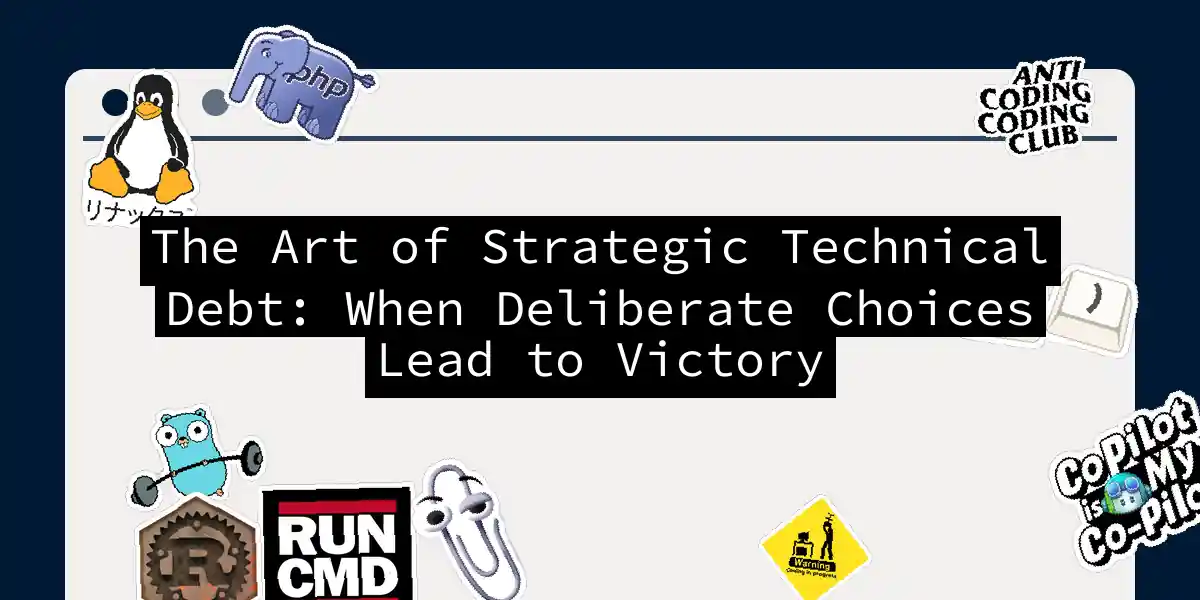Why Engineers Should Embrace Calculated Risk
You know the drill: “It’s better to ask for forgiveness than permission.” But what happens when that ethos meets your codebase? Strategic technical debt isn’t about cutting corners - it’s about intentional trade-offs that balance short-term needs with long-term sustainability. Think of it as the software equivalent of burning the midnight oil to meet a critical deadline while planning an IV drip for the inevitable crash.
In this article, we’ll explore how to create technical debt like a pro - with purpose, measurement, and a clear repayment plan. Because sometimes, “good enough” really is… good enough.
The Debt Decision Matrix
This simple flowchart encapsulates the four quadrants of technical debt from Asana’s framework, but with a crucial twist: strategic debt requires continuous assessment.
Scenario: Your team needs to launch a new feature in 6 weeks. You could:
- Build a pristine, microservices-based architecture (6 months)
- Hack together a monolithic solution with planned refactoring (+3 months)
The second option becomes prudent and deliberate debt - you’re trading code quality for market timing, but with a clear roadmap for future cleaning.
Code Example: The Temporary API Wrapper
When integrating with a third-party service that’s still evolving, sometimes you need an adapter:
# api_wrapper.py (Version 1 - Quick & Dirty)
import requests
def get_user_data(user_id):
response = requests.post(
"https://api.thirdparty.com/v1/users",
json={"user_id": user_id},
timeout=5 # Here's the debt: No retries, no error handling
)
return response.json()["data"]
This implementation satisfies the immediate requirement but ignores essential resilience features. Key trade-offs:
- Pros: Shipped on time, met business needs
- Cons: Single point of failure, high operational risk
Repayment Plan:
- Feature Request: Add retry logic with exponential backoff
- Sprint Task: Implement circuit breaking pattern
- Tech Initiative: Abstract API calls into microservices
By labeling this debt explicitly, you transform it from a liability into a developer’s “todo list.”
The Strategic Debt Checklist
For every intentional choice, ask yourself:
| Question | Yes → Proceed | No → Reject | |
|---|---|---|---|
| Is the benefit quantifiable? | Business impact aligns with debt | Unclear ROI | |
| Does the code touch critical paths? | Patched quickly if issues arise | Mission-critical components | |
| Can we afford the interest? | Team capacity for future refactoring | Already drowning in tech debt |
This matrix helps distinguish reckless deliberate debt (cutting corners in core infrastructure) from prudent decisions that buy time for innovation.
When to Pay Early
Some debts compound faster than others. For example, test automation debt might seem harmless but:
| Debt Type | Interest Rate | Repayment Priority | |
|---|---|---|---|
| Documentation Debt | 5% → 15% | Medium | |
| Test Automation Debt | 20% → 80% | High | |
| Code Duplication | 10% → 30% | Low |
In high-performing teams, even 5% interest can become unsustainable over time.
Data Point: According to GitHub’s analysis, codebase complexity grows exponentially with unaddressed debt. A 10% code duplication rate that takes 2 hours to fix today might become a 6-month refactor project later.
The Developer’s Debt Register
Implementing a debt tracking system isn’t about bureaucracy - it’s about making invisible costs visible.
Implementation Steps:
- Create a Debt Board: Visualize all tech debt items in Confluence/Notion
- Assign Owners: Every debt should have a developer volunteered to repay it
- Link to Features: Tag debt items connected to specific user stories
Case Study: The Monetized Debt
One creative approach came from a team that turned debt repayment into a business feature. They replaced a clunky data parser with a more robust solution that:
- Solved Customer Pain: Accepted multiple file formats
- Created New Use Case: Enabled data transformation pipelines
- Paid Debt: Removed dependency hell from core code
As Tom Harrison noted, this approach transforms “ugly debt” into marketable features while cleaning the codebase.
Key Insight: Technical debt isn’t an enemy but a strategic resource when managed proactively.
Final Thoughts: The Debt Therapist
At its core, strategic debt management is about calculated risk-taking. Remember:
- Plan Debt Repayment: Treat it like a loan application
- Contain Debt Issuance: Use architectural boundaries to limit spread
- Communicate Clearly: Debt is a team sport, not a secret
As the great Agile guru Ward Cunningham once said, “With technological debt, you can’t refactor forever.” But with proper planning, you might just buy enough time to innovate before the interest becomes overwhelming.
